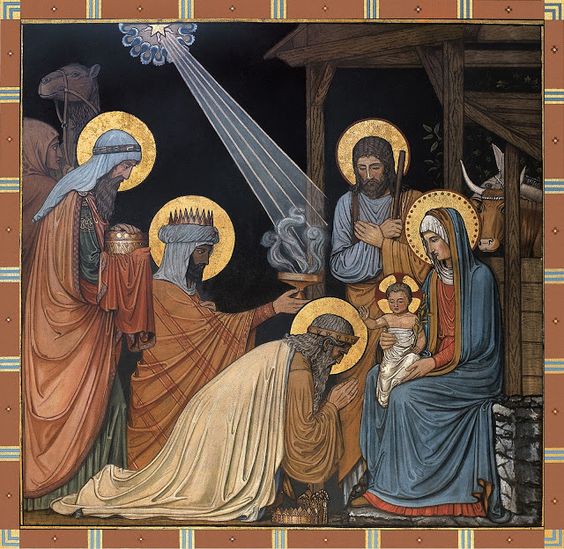Christ’s Manifestation in Mary

Stella Ista
The fifth antiphon for the Epiphany is a sweet, yet somehow haunting, seventh mode melody. As it is sung again and again, at Lauds, None, and Vespers for days in a row, it becomes a source of constant meditation, a sort of backdrop for the day.
Stella ista sicut flamma coruscat, et Regem regum Deum demonstrat: magi eam viderunt, and magno Regi munera obtulerunt.
This Star shines like a flame of fire and shows forth God, the King of Kings. The magi saw her and offered gifts to the Great King.
The seventh mode is the angelic mode, used for when angels come, or when messages are given from heaven. The star in this antiphon is itself the angel, that is, the messenger. But who is this star? From a literal point of view, of course, the star that led the magi to the Lord was a heavenly body, something astronomically visible. But I wonder if the antiphon does not tell us something more than this? Could not the star that led the magi to the Christ Child be the Star of the Sea, the Blessed Virgin Mary?
Today’s Marian O Antiphon, the last of the Marian O Antiphons, strikes a similar note.
September 7, O Stella Jacob
| ANT. O Stella Jacob fulgida, Stella nuntia lucis, Stella splendida et matutina! Veni, noli tardare: appare nobis, et per salutis viam deduc nos prævia ad diem supremum. | ANT. O Gleaming Star of Jacob, O Star that is the Messenger of the Light, O shining and morning Star! Come, tarry not, appear to us, and, going before us, lead us through the way of Salvation to that greatest of days! |
| ℣. Orietur Stella ex Jacob. ℟. Et consurget virga de Israel. |
℣. A Star shall arise from Jacob. ℟. And a rod shall spring up from Israel. |
| Oremus. Dulcissimum Mariæ Nomen invocantibus servulis per te, Regina clemens, gratiæ suæ munera largiatur Jesus Christus Filius tuus, qui cum Patre et Spiritu Sancto vivit et regnat Deus per omnia sæcula sæculorum. Amen. |
Let us pray. O Most Clement Queen, may thy Son, Jesus Christ, grant to those that call upon the sweetest name of Mary, to thy little servants, His gifts of grace through thee. He Who liveth and reigneth with the Father and the Holy Spirit, God, through all ages of ages. Amen. |
Numbers 24:7 prophecies the coming of the Lord Jesus, calling Him the sceptre that shall come out of Israel:
A star shall rise out of Jacob and a sceptre shall spring up from Israel.
Although, in its original meaning, this may have been a form of poetic parallelism, the star and the sceptre both referring to the same person, it is pleasant to think of the star as the Blessed Virgin Mary, whom the astronomical star of Bethlehem represented. She is the “Morning Star” that heralds the dawn of day. May she lead us to Jesus. May the light of her birth be a light proportioned to our weak eyes, a light that tells us that the Glory of God now shines in the Human Face of Christ. May she pray for us that, in our own measure, our faces too may radiate the Light of the Son of God.
An Unusual Collect
One final note must be made about our prayer for today. It diverges from the classical form of the collect, which most anciently was directed to the Father, and eventually came to be directed to the Son as well. It is as if our joy in expecting the infant face of the new-born queen has overflowed our hearts, and we are unable to withstrain ourselves from addressing her directly, she whose Son lives and reigns forever and ever. Amen.
